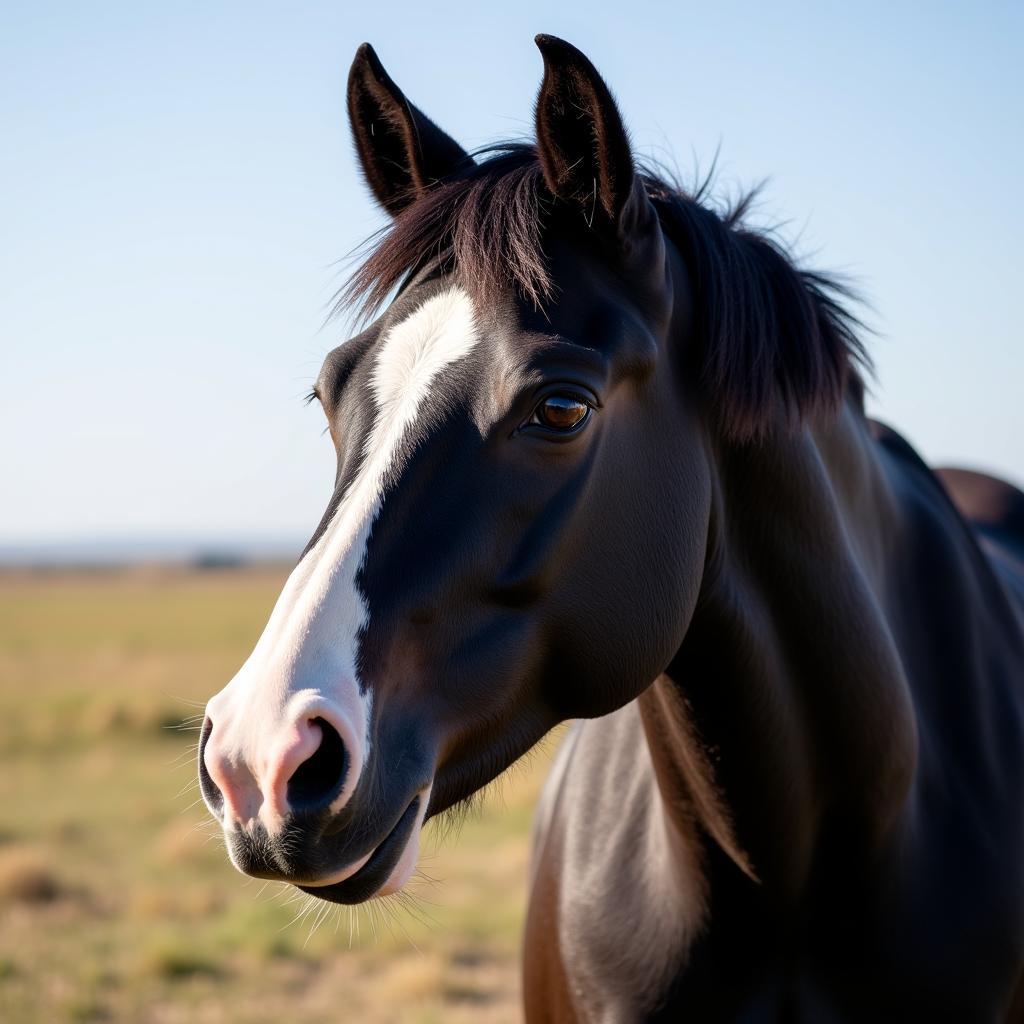A Large Black And White Horse Picture can be a breathtaking sight. The stark contrast of light and shadow highlights the animal’s powerful muscles and graceful movements, creating a timeless and elegant image. But capturing the perfect shot requires more than just pointing and clicking. Whether you’re a professional photographer or an amateur horse enthusiast, understanding the nuances of equine photography can elevate your photos from ordinary to extraordinary.
 Black and White Horse Portrait in Open Field
Black and White Horse Portrait in Open Field
Choosing Your Subject: Breed and Conformation
The first step to capturing stunning large black and white horse pictures is choosing the right subject. Certain breeds are known for their striking black and white markings, each with unique characteristics that lend themselves well to photography. Consider the bold patterns of a Friesian, the elegant spots of an Appaloosa, or the pinto’s contrasting patches.
Beyond breed, pay attention to the horse’s conformation, or physical structure. A well-conformed horse with balanced proportions and graceful lines will naturally create a more pleasing image.
Mastering Light and Shadow
Light is the most crucial element in any photograph, and black and white photography relies even more heavily on the interplay of light and shadow to create depth and drama.
- Soft, diffused light: Overcast days or shooting during the golden hours (shortly after sunrise and before sunset) provide soft, even lighting that flatters the horse’s coat and minimizes harsh shadows.
- Backlighting: Positioning the sun behind the horse can create a stunning halo effect, highlighting the horse’s outline and mane.
- Sidelighting: Light coming from the side emphasizes the horse’s muscle definition and creates dynamic shadows that add dimension to the image.
Experiment with different lighting angles and times of day to find what works best for your subject and desired mood.
Composition: Telling a Story with Your Image
A well-composed photograph guides the viewer’s eye and evokes emotion. When composing your large black and white horse picture, consider these tips:
- Rule of thirds: Imagine your frame divided into nine equal parts by two horizontal and two vertical lines. Place your subject at one of the intersecting points to create a more balanced and visually appealing image.
- Leading lines: Use natural elements like fences, trees, or even the horse’s own body to draw the viewer’s eye toward the main subject.
- Negative space: Don’t be afraid to leave empty space around your subject. This helps isolate the horse and draws attention to its form.
Capturing Emotion and Movement
A truly captivating horse photograph goes beyond simply documenting the animal’s appearance; it captures its spirit and personality.
- Patience is key: Horses are expressive creatures, but those fleeting moments of emotion can be easy to miss. Spend time observing your subject, anticipating their movements, and be ready to click the shutter when you see a spark in their eye or a playful flick of their tail.
- Freeze the action: To capture the power and grace of a horse in motion, use a fast shutter speed to freeze the action without blurring. Panning, or moving your camera along with the horse as it runs, can create a sense of movement while keeping the subject sharp.
Expert Insight: A Professional Photographer’s Perspective
“When photographing horses, I always try to connect with them on an emotional level,” says renowned equine photographer, Sarah Williams. “It’s about capturing their individual personalities and the unique bond they share with humans. Black and white photography, in particular, allows me to strip away distractions and focus on the raw beauty and power of these magnificent animals.”
Conclusion: Creating Timeless Equine Art
A large black and white horse picture can be a stunning addition to any art collection or a cherished personal keepsake. By understanding the elements of equine photography and applying your creative vision, you can capture the unique beauty and spirit of these magnificent creatures in a way that is both timeless and unforgettable.
Remember to experiment, have fun, and let your passion for horses shine through in your photography.
For all your equine needs and expert advice, contact Justus Horses USA at 0772127271, email us at [email protected], or visit our location at QGM2+WX2, Vị Trung, Vị Thuỷ, Hậu Giang, Vietnam. Our dedicated team is available 24/7 to assist you.